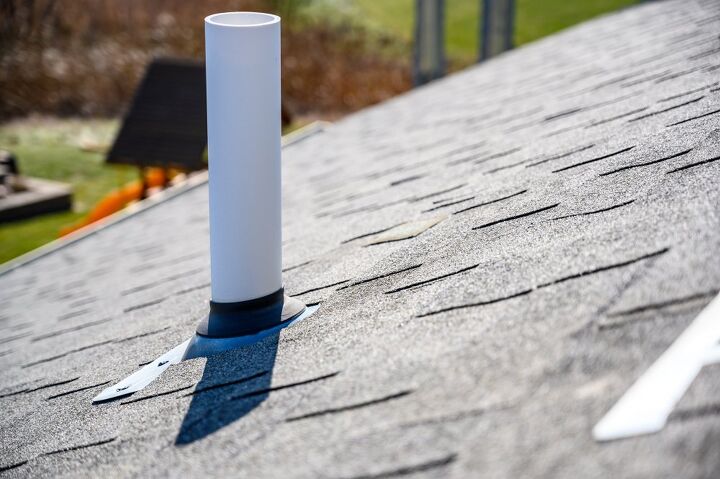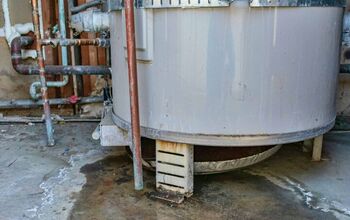Why Would There Be Water In A Vent Pipe?

Vent pipes in your home require regular inspection and maintenance. Inspections should include checking the vent pipe for standing water. There should never be standing water in a properly operating vent pipe. You may wonder why standing water would be found in a vent pipe?
Vent pipes exist to allow the sewer lines in your home to “breathe.” The wastewater systems in your home need air to flow properly. Without an adequate supply of air, drains may flow slowly or not flow at all. In addition, without the vent pipes operating properly, the drain system may allow sewer gases to flow back into your home.
Vent pipes are an integral part of a properly designed and installed waste system in your home. Like all other plumbing in your house, vent pipes require periodic maintenance and inspection. This maintenance and inspection include visual inspections of the vent pipe itself. A bit of preventative maintenance will often prevent more damaging problems in the future.
Do You Need Ducts or Vents Installation or Replacement?
Get free, zero-commitment quotes from pro contractors near you.

How Do Vent Pipes Work In Your Sewer System
The drainage pipes in your home are part of a system of drains, p-traps, and vents that must work together to keep your sewage system flowing freely and efficiently. The drain pipes carry the wastewater from your home to connect to the municipal sewer pipes or your septic system.
Each drain in your home has a p-trap. The p-trap in the system holds a small amount of water. This water creates a plug in the drainpipe system to keep sewer gases from coming back into the house through the sewer pipes.
Vent pipes are installed throughout the drainage system for two important reasons. First, the vent pipes allow any sewer gases to escape easily outside your home. Since the vent pipes exit through the roof, the sewer gases are directed up and outside your home.
Second, when your washing machine drains or you flush a toilet, the water sent into the drain system also needs air as it moves along the pipe. The vents in your drainage system allow the wastewater to flow freely with adequate air.
What Can Go Wrong With Vent Pipes?
For the most part, vent pipe systems in your home are virtually problem-free. However, some situations can result in a problem with a vent pipe. Regular inspection and maintenance can forestall many of these problems. These are the most common causes for a vent pipe holding water or not allowing air back into the sewer lines.
A Clogged Vent Pipe
The most common cause of a vent pipe holding water is a clog in the vent pipe. A clog can happen in several ways. What matters most is that the clog be cleared and the water allowed to drain from the vent pipe. Clogs can occur for several reasons.
- Bird nests – Birds may find your vent pipes a convenient place to build a nest. However, if the nest falls into the vent pipe, it can cause a clog to capture rain and hold water inside the vent pipe. If the pipe holds water, it can’t pass air into the sewer lines.
- Dead animals – It isn’t a pleasant thought, but there are cases where animals get trapped in a drainpipe and die. Birds, squirrels, and other small animals are most susceptible to this fate. Like a bird’s nest, a dead animal can cause a clog to hold water in the drainpipe and prevent the vent from performing properly.
- Waste Material – It is unusual, but it can happen. If you have experienced a clogged sewer line, it may have backed up waste material into a vent pipe, forming a plug of waste material in the pipe. This material can hold water and prevent the vent from allowing air to flow into the drain system when necessary.
Improperly installed vent pipe
In some cases, vent lines in a home may have horizontal runs to bypass an obstruction in the attic space. Two-story houses may have horizontal vent pipes to get to a space that will allow the vent to exit through the roof. If the vent pipe sags or doesn’t have the proper slope, the vent pipe may hold water.
If you find a vent pipe that is not properly installed, the condition must be remedied promptly. It is often best to contact a licensed plumber to make these repairs. This will ensure that the vent pipe is repaired and operating correctly.
How Do I Unclog a Vent Pipe?
You must keep your vent pipes open so that your drain pipes operate properly. If you find a clogged vent pipe holding water, you must remove the clog and get the air flowing again to your drain system. To unclog a vent pipe, these steps are our recommendation.
Step 1: Gather your Tools and Equipment
To safely and easily clear a clog in ya vent pipe, you will need the following equipment and tools. Having everything you need assembled before starting a project eliminates frustration and delays.
- A ladder to access the roof and the vent pipe
- A plumbers snake or electricians fish tape to reach the clog
- A flashlight to see down the vent pipe
- Gloves to protect your hands
- Safety glasses to protect your eyes
- A water hose to flush the vent pipe after the clog is removed
Step 2: Work Safely on the Roof
Working on a roof is always a risky proposition. Never work on a roof during inclement weather. Rain and snow can make the roof surface treacherous and lead to disaster. If you are using an electric plumbers snake, moisture can easily lead to electrical shocks that can be deadly. If you have any concerns about working on your roof, call a professional to unclog your vent pipe.
Step 3: Check the Vent Pipe
Use the flashlight to check down the vent pipe and ensure the clog is still there. Sometimes clogs resolve themselves without any assistance. If you can still see the clog or standing water. You should move on to the next step.
Step 4: Run the Plumbers Snake or Electrician Fish Tape Down the Vent Pipe
Start the plumber’s snake and carefully feed the end down the vent pipe. Work slowly to ensure that you don’t damage the vent pipe. Caution is especially important if your vent pipes are made of PVC.
You may be able to feel when the end of the plumber’s snake finds the clog and begins to cut through. Let the plumber’s snake do the work. Don’t try to force the snake through the clog. If you try to force the snake through the clog, you may push the clog into the drainpipes below. This can cause even bigger problems if it plugs the sewer lines.
Step 5: Remove the Snake and Flush the Vent Pipe
Remove the plumber’s snake from the vent pipe. Check the vent pipe again with your flashlight. Flush the vent pipe with the water hose if you can not see the clog or standing water. The water should clear any remaining debris in the vent pipe and flush the remainder of the clog out of your sewer lines.
Do You Need Ducts or Vents Installation or Replacement?
Get free, zero-commitment quotes from pro contractors near you.

Vent Pipes that Hold Water – Not a Good Sign
If you find a vent pipe on your home holding water, the cause is more than likely a clog in the vent pipe. The clog must be removed to ensure that the sewer system serving the drains in your home works properly. With care, a homeowner can unclog a vent pipe without problems. However, a professional must be called in to fix the problem under some circumstances.

Dennis is a retired firefighter with an extensive background in construction, home improvement, and remodeling. He worked in the trades part-time while serving as an active firefighter. On his retirement, he started a remodeling and home repair business, which he ran for several years.
More by Dennis Howard














![The 10 Best Table Saws - [2022 Reviews & Buyer's Guide]](https://cdn-fastly.upgradedhome.com/media/2023/07/31/9070645/the-10-best-table-saws-2022-reviews-buyer-s-guide.jpg?size=350x220)












